Germain Théodore Clément Ribot, a French painter of the 19th century, carved out a niche for himself primarily as a specialist in still life compositions. Born into an artistic family, his career, though relatively brief and often overshadowed by that of his more famous father, contributed to the rich tapestry of French art during a period of significant stylistic evolution. His work, characterized by a keen observation of light and texture, appealed to the tastes of the burgeoning middle-class art market of his time.
Early Life and Artistic Lineage
Germain Théodore Clément Ribot, whose full name is often cited as Clément-Théodule-Gérard Ribot, was born in Paris on February 18, 1845. He was the son of the esteemed painter Théodule-Augustin Ribot (1823-1891), a prominent figure in the French Realist movement. Growing up in such an environment undoubtedly immersed young Germain in the world of art from his earliest years, providing him with both inspiration and a foundational understanding of artistic practice.
His father, Théodule-Augustin Ribot, was known for his somber-toned genre scenes, portraits, and still lifes, often drawing comparisons to Spanish Golden Age masters like Jusepe de Ribera and Diego Velázquez, as well as to the Dutch masters. This paternal influence was significant, not only in terms of technical approach but also in fostering a dedication to the principles of Realism, which emphasized the depiction of everyday subjects with truthfulness and sincerity.
Beyond the tutelage of his father, Germain Ribot also studied under Antoine Vollon (1833-1900). Vollon was a celebrated painter in his own right, particularly renowned for his lush and masterful still lifes, as well as landscapes and genre scenes. Vollon's own work often displayed a rich impasto and a vibrant sense of materiality, qualities that likely informed Germain Ribot's developing style. This formal training, combined with the informal education received at home, equipped Ribot with a solid technical grounding.
Artistic Style and Thematic Focus
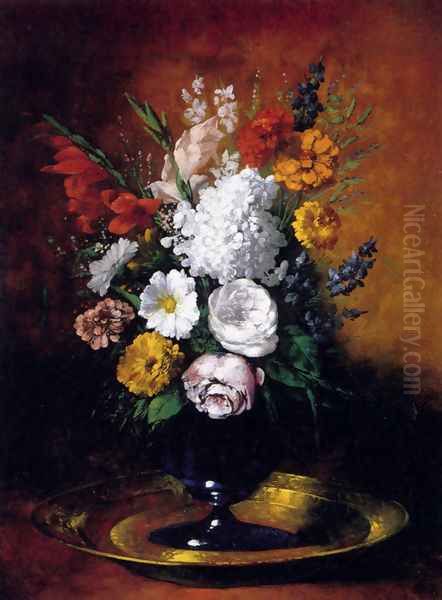
Germain Ribot’s artistic output predominantly centered on still life painting, with a particular fondness for floral compositions. His style can be situated within the broader Realist tradition, yet it often possessed a decorative quality that distinguished it from the more austere or socially-conscious works of some of his Realist contemporaries like Gustave Courbet or Jean-François Millet, whose focus was more on peasant life and social commentary.
Ribot's still lifes are noted for their careful attention to the interplay of light and shadow, a skill likely honed under the influence of both his father and Vollon. He demonstrated a sensitivity to the textures of different objects, whether the delicate petals of a flower, the sheen of a ceramic vase, or the gleam of fruit. His color palettes, while often grounded in naturalistic tones, could also incorporate brighter hues, especially in his floral pieces, lending them an appealing vibrancy.
His works catered to the tastes of the 19th-century middle-class clientele, who sought art that was both aesthetically pleasing and suitable for domestic interiors. Floral still lifes, in particular, were a popular genre, symbolizing beauty, transience, and the bounty of nature. Ribot’s paintings in this vein often featured arrangements of flowers such as poppies, cornflowers, roses, and chrysanthemums, rendered with a delicate touch and an eye for botanical accuracy.
While his father’s still lifes sometimes carried a more profound, almost melancholic weight, Germain’s approach often leaned towards a lighter, more overtly decorative sensibility. He was adept at capturing the ephemeral beauty of flowers, emphasizing the way light would catch upon their petals and leaves, creating a sense of immediacy and freshness. This focus on light effects, while not Impressionistic in execution, shows an awareness of the visual phenomena that were also preoccupying many artists of his generation.
Career and Salon Exhibitions
Germain Ribot’s professional career as a painter was primarily active during the 1870s and early 1880s. He made his debut at the prestigious Paris Salon in 1870, exhibiting a work titled "Science et Art: Nature morte" (Science and Art: Still Life). The Salon was the official art exhibition of the Académie des Beaux-Arts in Paris and the most important venue for artists to gain recognition and patronage.
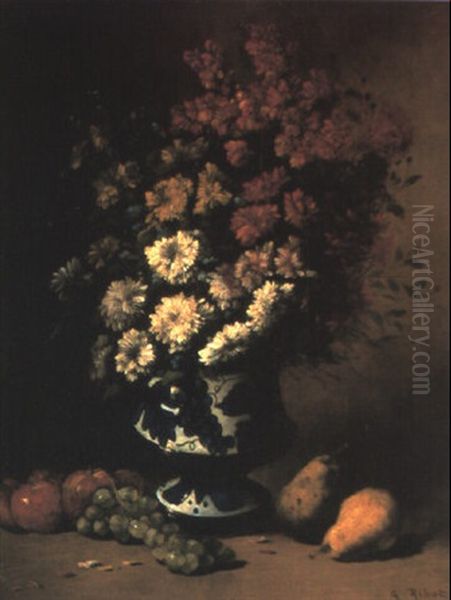
He continued to exhibit at the Salon in subsequent years. For instance, in 1875, he presented a painting simply titled "Fleurs" (Flowers), underscoring his commitment to the floral still life genre. His participation in the Salon indicates his adherence to the established academic system, even as more radical artistic movements like Impressionism were beginning to challenge its dominance. Artists like Claude Monet, Pierre-Auguste Renoir, and Edgar Degas were, during this same period, organizing their own independent exhibitions.
In 1876, Germain Ribot moved to Montmartre, a Parisian district increasingly known for its bohemian atmosphere and artistic community. This move might suggest a desire for greater independence or immersion in a lively artistic milieu. By 1879, he exhibited a portrait at the Salon, a departure from his usual still life submissions. This was reportedly the last time he exhibited alongside his father and sister, Louise-Aimée Ribot, who was also a painter.
His period of active exhibition appears to have concluded around 1883. In that year, he reportedly returned to live with his father and exhibited works at the Salon independently. After this point, his presence in the public art scene seems to diminish significantly.
Representative Works
Identifying a comprehensive list of Germain Ribot's major works is somewhat challenging, as his oeuvre is not as extensively documented as that of more prominent artists. However, based on Salon records and attributed pieces, several works can be highlighted:
"Science et Art: Nature morte" (1870): His Salon debut piece. The title suggests a composition that might have juxtaposed objects symbolic of scientific inquiry with those representing artistic creation, a common allegorical theme in still life.
"Fleurs" (1875): A straightforward floral still life, indicative of his primary specialization. Such works would have showcased his skill in rendering the delicate forms and colors of flowers.
"Poppies and Cornflowers": A painting attributed to him, currently in the collection of the Cleveland Museum of Art. This work exemplifies his ability to create vibrant and texturally rich floral compositions, with a keen sense of light playing across the petals.
Various untitled still lifes: Many of his works are simply titled "Still Life with Flowers," "Still Life with Fruit," or similar descriptive phrases. These typically feature carefully arranged bouquets in vases, often accompanied by fruit or other small objects, set against a neutral or subtly textured background.
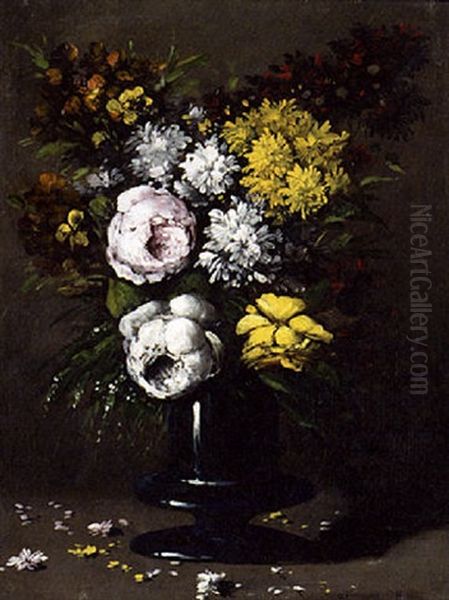
His paintings often display a competent, if not groundbreaking, approach to the still life genre. They are characterized by solid composition, skilled rendering of textures, and an appealing use of color and light. While he may not have pushed the boundaries of art in the way that the Impressionists or Post-Impressionists like Vincent van Gogh or Paul Cézanne did, his work represents a consistent and accomplished contribution to a long-standing tradition.
Relationship with Contemporary Artists
Germain Ribot’s most significant artistic relationships were undoubtedly with his father, Théodule-Augustin Ribot, and his teacher, Antoine Vollon. These two figures shaped his foundational artistic development.
Théodule-Augustin Ribot (Père): The influence of his father was pervasive. Théodule-Augustin was a respected figure in the Realist movement, known for his strong chiaroscuro and his empathetic depictions of ordinary people. While Germain focused more on still life, the commitment to verisimilitude and the careful observation of light were traits likely inherited or learned from his father. They also exhibited together at the Salon on several occasions.
Antoine Vollon: As his teacher, Vollon would have provided direct instruction and critique. Vollon was a master of still life, celebrated for his technical virtuosity and his ability to imbue everyday objects with a sense of grandeur. His influence can be seen in Germain’s rich paint application and his attention to the tactile qualities of the subjects he depicted. Vollon himself was a contemporary of artists like Henri Fantin-Latour (1836-1904), another preeminent still life painter of the era, whose work Germain would also have been aware of.
Beyond these direct connections, Germain Ribot operated within a Parisian art world populated by numerous talents. The Realist movement, championed by Gustave Courbet (1819-1877), had already made a profound impact. While Ribot's still lifes were generally less confrontational than Courbet's large-scale social statements, the underlying principle of depicting the world truthfully was a shared tenet.
He would have been aware of the Barbizon School painters, such as Jean-François Millet (1814-1875) and Théodore Rousseau (1812-1867), who emphasized naturalism in landscape and rural scenes. The rise of Impressionism in the 1870s, with figures like Claude Monet (1840-1926), Camille Pissarro (1830-1903), and Berthe Morisot (1841-1895), represented a radical shift towards capturing fleeting moments and the effects of light and color, a direction Germain Ribot did not overtly follow, remaining closer to traditional Realist techniques.
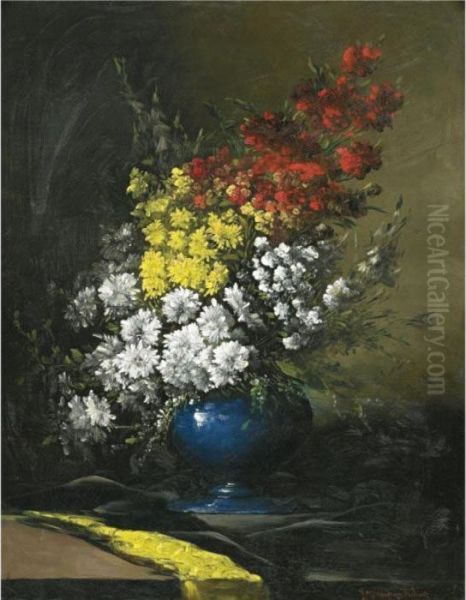
Other still life painters active during his time, besides Fantin-Latour and Vollon, included artists like Philippe Rousseau (1816-1887, not to be confused with Théodore Rousseau), who also specialized in the genre. The tradition of still life painting in France had a long and distinguished history, tracing back to masters like Jean-Baptiste-Siméon Chardin (1699-1779) in the 18th century, whose work continued to be revered and studied. The influence of Dutch Golden Age still life painters such as Willem Kalf (1619-1693) and Jan Davidsz. de Heem (1606-1684) also remained a potent force in the genre.
While specific records of close friendships or collaborations with many of these broader contemporaries are scarce, Germain Ribot was undoubtedly part of this dynamic artistic ecosystem, absorbing influences and contributing his own particular vision.
Later Years, Disappearance from the Art Scene, and Legacy
After his Salon exhibition in 1883, Germain Théodore Clément Ribot seems to have largely withdrawn from the public art world. The reasons for this are not definitively known, but some art historical accounts suggest that he may have suffered from health problems. This period of withdrawal coincided with the later years of his father, who passed away in 1891.
Germain Ribot himself died relatively young, on September 11, 1893, in Paris, at the age of 48. His comparatively short career and his focus on a less revolutionary style of painting meant that he did not achieve the same level of fame as some of his more avant-garde contemporaries or, indeed, his own father.
Consequently, much of his work remains in private collections, and a significant number of his paintings may be unidentified or misattributed. This makes a comprehensive assessment of his oeuvre challenging for art historians. His legacy is primarily that of a competent and dedicated still life painter who worked within the Realist tradition, producing works of quiet beauty and technical skill.
It is important to distinguish his artistic identity from that of his father. Théodule-Augustin Ribot is recognized for a broader range of subjects, including poignant genre scenes of cooks, seamstresses, and musicians, often characterized by a dramatic use of chiaroscuro reminiscent of Caravaggio or Ribera. His works often carried a greater emotional weight and social resonance. Germain, by contrast, seems to have found his primary mode of expression in the more intimate and decorative realm of still life, particularly floral arrangements.
Position Relative to Impressionism and Post-Impressionism
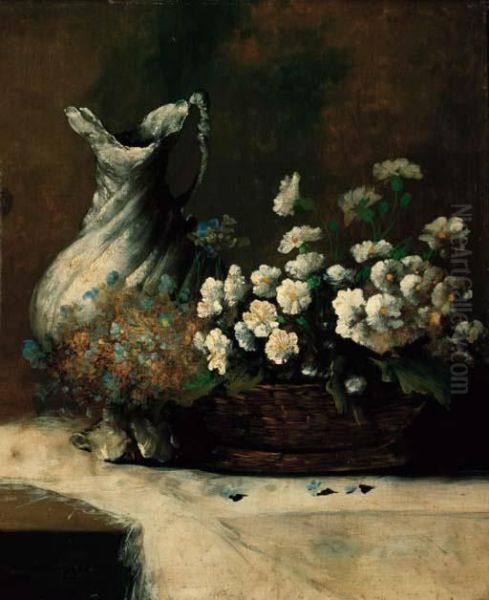
Germain Théodore Clément Ribot was a contemporary of the Impressionist and Post-Impressionist movements, but his artistic approach remained firmly rooted in Realism. The Impressionists, who held their first group exhibition in 1874, were revolutionizing painting with their emphasis on capturing the fleeting effects of light and atmosphere, their use of broken brushwork, and their brighter palettes. Artists like Monet, Renoir, Degas, and Pissarro were moving away from the detailed finish and traditional subject matter favored by the Salon.
Ribot, while sensitive to light in his own way, did not adopt the techniques or the theoretical underpinnings of Impressionism. His brushwork was generally more controlled, his forms more solidly defined, and his compositions more traditional. He continued to exhibit at the Salon, the bastion of academic art, rather than aligning himself with the independent Impressionist exhibitions.
Similarly, the Post-Impressionist artists who followed, such as Vincent van Gogh (1853-1890), Paul Gauguin (1848-1903), Paul Cézanne (1839-1906), and Georges Seurat (1859-1891), pushed artistic boundaries even further, exploring subjective expression, symbolism, structural form, and scientific color theories. Ribot’s work does not show engagement with these radical new directions.
Therefore, Germain Ribot should be understood as an artist working within the established traditions of his time, refining his craft in the specific genre of still life, rather than as a participant in the avant-garde movements that were reshaping the landscape of European art. His contribution lies in his skillful continuation of the Realist still life tradition.
Conclusion
Germain Théodore Clément Ribot remains a figure of modest renown in the annals of 19th-century French art. As the son of a more celebrated painter and a student of the accomplished Antoine Vollon, he was well-schooled in the techniques of Realism. He applied these skills with dedication to the genre of still life, creating works that were appreciated for their beauty, their fidelity to nature, and their sensitive rendering of light and texture.
While his career was relatively short and he did not achieve the transformative impact of the Impressionists or Post-Impressionists, his paintings offer a valuable glimpse into the artistic tastes and production of his era. His floral still lifes, in particular, stand as charming examples of a genre that continued to thrive, providing both aesthetic pleasure and a testament to the enduring appeal of nature's beauty as an artistic subject. His work serves as a reminder of the many talented artists who contribute to the richness of art history, even if they do not always occupy the brightest spotlights.